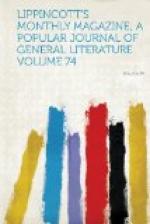The notices which Professor Rossi has collected from the various collections of archives explored by him show in a remarkable manner how much the best patron of art and artists in those days was the Church. By far the greatest number of the contracts cited are made by ecclesiastics, either monks or collegiate bodies of canons or the like, for the ornamentation of their churches and sacristies. The next best patrons are the different trade-guilds of the cities. Each of these had its place of meeting for the priori—masters or wardens, as we should say, of the company—and many of them a contiguous chapel. The sort of furniture needed for these places was generally a range of seats running round the principal room, a back of wainscoting behind them, a kind of pulpit for those who addressed the meeting, a raised and prominent seat for the “consuls” of the guild, and a large table or writing-desk for the transaction of business. All this, as will be readily perceived, afforded fine opportunities for the display of rich carvings and intarsia; and there was much rivalry between the guilds in the splendor and adornment of their places of meeting. Some of these works still remain intact, as in the case of the meeting-room and chapel of the company of exchange-brokers, which is celebrated wherever art is valued for the magnificent frescoes by Perugino which adorn the upper part of the walls above the wood-work. I think, however, that the Church was more liberal and magnificent in her orders. I have seen much fine wood-work in the different guild-halls and town-halls in various cities of Italy, but in no lay building, not even in wealthy and magnificent Venice itself, with all the splendor of its ducal palace and its Scuole, have I ever seen anything of the kind at all comparable to the wood-work in the choirs of the monastery of St. Peter at Perugia and of the cathedral at Siena. There is in the cathedral of Bergamo some intarsia, perhaps the finest things extant in that special description of work, but for carving the choirs I have mentioned are pre-eminent.
But there are a great number of beautiful works of this sort lurking in places where the traveler, however eager a lover of art, would hardly think of looking for them. The central districts of Italy are full of such. There is in the mountains to the south of Perugia, overhanging the valley of the Tiber, a little city, the very name of which will probably be new to many even of those who have traveled much in Italy. Still less likely is it that they have ever been at Todi, for that is the name of the place I am alluding to. It lies high and bleak among the Apennines, and possesses nothing to attract the wanderer save some notable remains of mediaeval art which strikingly show how universal, how ubiquitous, art and artists were in those halcyon days. Todi has, moreover, the misfortune of being situated on no line of railway, and of not being on the way to any of the great modern centres. It is, therefore,




